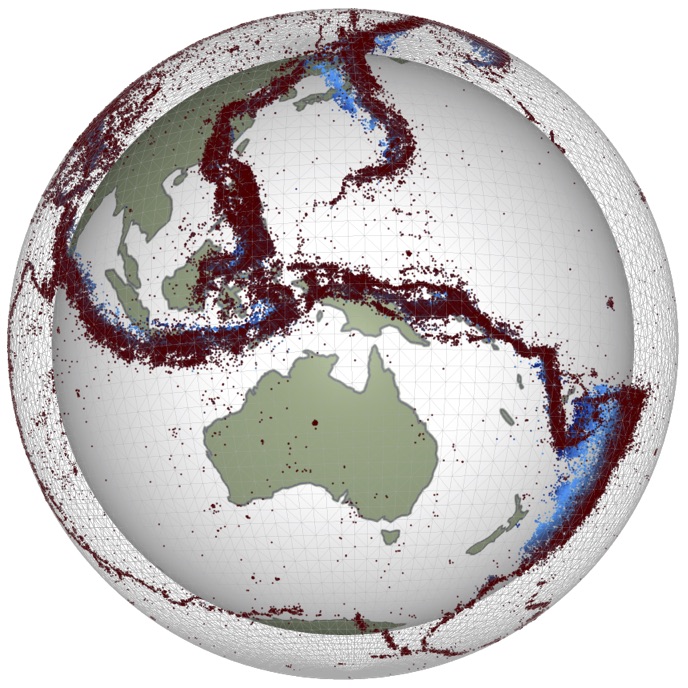Stokes in a disc with adv_diff to solve T and back-in-time sampling with particles#
This is a simple example in which we try to instantiate two solvers on the mesh and have them use a common set of variables.
We set up a v, p, T system in which we will solve for a steady-state T field in response to thermal boundary conditions and then use the steady-state T field to compute a stokes flow in response.
The next step is to add particles at node points and sample back along the streamlines to find values of the T field at a previous time.
(Note, we keep all the pieces from previous increments of this problem to ensure that we don’t break something along the way)
# to fix trame issue
# import nest_asyncio
# nest_asyncio.apply()
import petsc4py
from petsc4py import PETSc
import underworld3 as uw
from underworld3.systems import Stokes
from underworld3 import function
import numpy as np
meshball = uw.meshing.Annulus(
radiusInner=0.5, radiusOuter=1.0, cellSize=0.1, degree=1, qdegree=3
)
# check the mesh if in a notebook / serial
if uw.mpi.size == 1:
import pyvista as pv
import underworld3.visualisation as vis
pvmesh = vis.mesh_to_pv_mesh(meshball)
pl = pv.Plotter(window_size=(750, 750))
# pl.add_mesh(pvmesh,'Black', 'wireframe', opacity=0.5)
pl.add_mesh(
pvmesh,
cmap="coolwarm",
edge_color="Black",
show_edges=True,
use_transparency=False,
opacity=0.5,
)
pl.show()
v_soln = uw.discretisation.MeshVariable("U", meshball, meshball.dim, degree=2)
p_soln = uw.discretisation.MeshVariable("P", meshball, 1, degree=1)
t_soln = uw.discretisation.MeshVariable("T", meshball, 1, degree=3)
t_0 = uw.discretisation.MeshVariable("T0", meshball, 1, degree=3)
swarm = uw.swarm.Swarm(mesh=meshball)
T1 = uw.swarm.SwarmVariable("Tminus1", swarm, 1)
X1 = uw.swarm.SwarmVariable("Xminus1", swarm, 2)
swarm.populate(fill_param=3)
# Create Stokes object
stokes = Stokes(
meshball, velocityField=v_soln, pressureField=p_soln, solver_name="stokes"
)
stokes.constitutive_model = uw.constitutive_models.ViscousFlowModel
stokes.constitutive_model.Parameters.viscosity = 1.0
# Set solve options here (or remove default values
# stokes.petsc_options.getAll()
stokes.petsc_options.delValue("ksp_monitor")
# Constant visc
stokes.viscosity = 1.0
# Velocity boundary conditions
stokes.add_dirichlet_bc((0.0, 0.0), "Upper", (0, 1))
stokes.add_dirichlet_bc((0.0, 0.0), "Lower", (0, 1))
# Create a density structure / buoyancy force
# gravity will vary linearly from zero at the centre
# of the sphere to (say) 1 at the surface
import sympy
radius_fn = sympy.sqrt(
meshball.X.dot(meshball.X)
) # normalise by outer radius if not 1.0
unit_rvec = meshball.X / (1.0e-10 + radius_fn)
gravity_fn = radius_fn
# Some useful coordinate stuff
x = meshball.X[0]
y = meshball.X[1]
r = sympy.sqrt(x**2 + y**2)
th = sympy.atan2(y + 1.0e-5, x + 1.0e-5)
# Create adv_diff object
# Set some things
k = 1.0
h = 0.0
r_i = 0.5
r_o = 1.0
adv_diff = uw.systems.AdvDiffusion(
meshball,
u_Field=t_soln,
V_fn=v_soln,
solver_name="adv_diff",
verbose=False,
)
adv_diff.constitutive_model = uw.constitutive_models.DiffusionModel
adv_diff.constitutive_model.Parameters.diffusivity = 1
adv_diff.theta = 0.5
# adv_diff.f = t_soln.fn / delta_t - t_star.fn / delta_t
# Define T boundary conditions via a sympy function
import sympy
abs_r = sympy.sqrt(meshball.rvec.dot(meshball.rvec))
init_t = 0.01 * sympy.sin(15.0 * th) * sympy.sin(np.pi * (r - r_i) / (r_o - r_i)) + (
r_o - r
) / (r_o - r_i)
adv_diff.add_dirichlet_bc(1.0, "Lower")
adv_diff.add_dirichlet_bc(0.0, "Upper")
with meshball.access(t_0, t_soln):
t_0.data[...] = uw.function.evaluate(init_t, t_0.coords).reshape(-1, 1)
t_soln.data[...] = t_0.data[...]
buoyancy_force = 1.0e6 * t_soln.sym[0] / (0.5) ** 3
stokes.bodyforce = unit_rvec * buoyancy_force
# check the stokes solve converges
stokes.solve()
# Check the diffusion part of the solve converges
adv_diff.petsc_options["ksp_monitor"] = None
adv_diff.petsc_options["monitor"] = None
adv_diff.solve(timestep=0.00001 * stokes.estimate_dt())
# diff = uw.systems.Poisson(meshball, u_Field=t_soln, solver_name="diff_only")
# diff.constitutive_model = uw.constitutive_models.DiffusionModel(meshball.dim)
# diff.constitutive_model.material_properties = adv_diff.constitutive_model.Parameters(diffusivity=1)
# diff.solve()
# check the mesh if in a notebook / serial
if uw.mpi.size == 1:
import pyvista as pv
import underworld3.visualisation as vis
pvmesh = vis.mesh_to_pv_mesh(meshball)
pvmesh.point_data["T"] = vis.scalar_fn_to_pv_points(pvmesh, t_soln.sym)
# pvmesh.point_data["Ts"] = vis.scalar_fn_to_pv_points(pvmesh, adv_diff._u_star.sym)
# pvmesh.point_data["dT"] = vis.scalar_fn_to_pv_points(pvmesh, t_soln.sym) - vis.scalar_fn_to_pv_points(pvmesh, adv_diff._u_star.sym)
velocity_points = vis.meshVariable_to_pv_cloud(stokes.u)
velocity_points.point_data["V"] = vis.vector_fn_to_pv_points(velocity_points, stokes.u.sym)
pl = pv.Plotter(window_size=(750, 750))
# pl.add_mesh(pvmesh,'Black', 'wireframe')
pl.add_mesh(
pvmesh,
cmap="coolwarm",
edge_color="Black",
show_edges=True,
scalars="T",
use_transparency=False,
opacity=0.5,
)
pl.add_arrows(velocity_points.points, velocity_points.point_data["V"], mag=0.0005)
# pl.add_arrows(arrow_loc2, arrow_length2, mag=1.0e-1)
# pl.add_points(pdata)
pl.show(cpos="xy")
# pvmesh.point_data["Ts"].min()
adv_diff.petsc_options["pc_gamg_agg_nsmooths"] = 1
# check the mesh if in a notebook / serial
if uw.mpi.size == 1:
import pyvista as pv
import underworld3.visualisation as vis
pvmesh = vis.mesh_to_pv_mesh(meshball)
pvmesh.point_data["T"] = vis.scalar_fn_to_pv_points(pvmesh, t_soln.sym) - vis.scalar_fn_to_pv_points(pvmesh, t_0.sym)
velocity_points = vis.meshVariable_to_pv_cloud(stokes.u)
velocity_points.point_data["V"] = vis.vector_fn_to_pv_points(velocity_points, stokes.u.sym)
pl = pv.Plotter(window_size=(750, 750))
# pl.add_mesh(pvmesh,'Black', 'wireframe')
pl.add_mesh(
pvmesh,
cmap="coolwarm",
edge_color="Black",
show_edges=True,
scalars="T",
use_transparency=False,
opacity=0.5,
)
# pl.add_arrows(arrow_loc, arrow_length, mag=0.025)
# pl.add_points(pdata)
pl.show(cpos="xy")
def plot_T_mesh(filename):
if uw.mpi.size == 1:
import pyvista as pv
import underworld3.visualisation as vis
pvmesh = vis.mesh_to_pv_mesh(meshball)
pvmesh.point_data["T"] = vis.scalar_fn_to_pv_points(pvmesh, t_soln.sym)
tpoints = vis.meshVariable_to_pv_cloud(t_soln)
tpoints.point_data["T"] = vis.scalar_fn_to_pv_points(tpoints, t_soln.sym)
tpoint_cloud = pv.PolyData(tpoints)
velocity_points = vis.meshVariable_to_pv_cloud(stokes.u)
velocity_points.point_data["V"] = vis.vector_fn_to_pv_points(velocity_points, stokes.u.sym)
pl = pv.Plotter(window_size=(750, 750))
pl.add_arrows(velocity_points.points, velocity_points.point_data["V"], mag=0.00002, opacity=0.75)
pl.add_points(
point_cloud,
cmap="coolwarm",
render_points_as_spheres=False,
point_size=10,
opacity=0.66,
)
pl.add_mesh(pvmesh, "Black", "wireframe", opacity=0.75)
pl.remove_scalar_bar("T")
pl.remove_scalar_bar("mag")
pl.screenshot(
filename="{}.png".format(filename),
window_size=(1280, 1280),
return_img=False,
)
# pl.show()
# Convection model / update in time
expt_name = "output/Cylinder_Ra1e6i"
for step in range(0, 50):
stokes.solve()
delta_t = 5.0 * stokes.estimate_dt()
adv_diff.solve(timestep=delta_t)
# stats then loop
tstats = t_soln.stats()
if uw.mpi.rank == 0:
print("Timestep {}, dt {}".format(step, delta_t))
# print(tstats)
# plot_T_mesh(filename="{}_step_{}".format(expt_name,step))
meshball.petsc_save_checkpoint(index=step,
meshVars=[v_soln, t_soln],
outputPath=expt_name)
# savefile = "output_conv/convection_cylinder.h5".format(step)
# meshball.save(savefile)
# v_soln.save(savefile)
# t_soln.save(savefile)
# meshball.generate_xdmf(savefile)
if uw.mpi.size == 1:
import pyvista as pv
import underworld3.visualisation as vis
pvmesh = vis.mesh_to_pv_mesh(meshball)
pvmesh.point_data["T"] = vis.scalar_fn_to_pv_points(pvmesh, t_soln.sym)
points = vis.meshVariable_to_pv_cloud(t_soln)
points.point_data["T"] = vis.scalar_fn_to_pv_points(points, t_soln.sym)
point_cloud = pv.PolyData(points)
velocity_points = vis.meshVariable_to_pv_cloud(stokes.u)
velocity_points.point_data["V"] = vis.vector_fn_to_pv_points(velocity_points, stokes.u.sym)
pl = pv.Plotter(window_size=(750, 750))
pl.add_arrows(velocity_points.points, velocity_points.point_data["V"], mag=0.00005, opacity=0.75)
# pl.add_arrows(arrow_loc2, arrow_length2, mag=1.0e-1)
pl.add_points(
point_cloud,
cmap="coolwarm",
render_points_as_spheres=True,
point_size=7.5,
opacity=0.75,
)
pl.add_mesh(pvmesh, scalars="T", cmap="coolwarm", opacity=1)
pl.show(cpos="xy")
